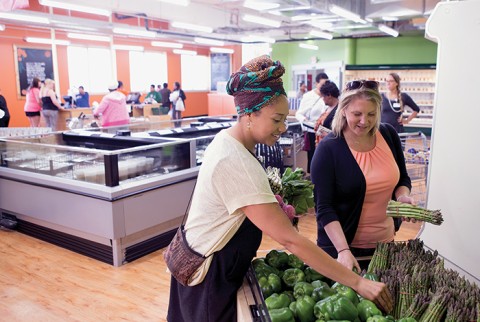Waste not, hunger not: Daily Table sells fresh meals cheap
Forty percent of the food produced in the U.S. ends up in landfills. Meanwhile, people are hungry. Daily Table tries to address both problems.

Every weekday a van pulls up at the back door of Daily Table, and chef Ismail Samad looks through donations from farmers’ markets, grocery stores, and manufacturers—food that would otherwise probably be wasted. He makes a careful selection and is soon at work transforming the food into carryout meals to sell at this nonprofit grocery store in Dorchester, Massachusetts.
The store was started in 2015 by Doug Rauch, formerly president of Trader Joe’s. Daily Table is an attempt to address two problems in American life: low-income people’s lack of access to healthy food and the massive amount of fresh food wasted by traditional grocery stores, growers, and manufacturers.
Read our latest issue or browse back issues.
Daily Table is part of a nationwide movement for food recovery which is responding to the fact that 40 percent of the food produced in the United States ends up in the nation’s landfills, where it releases 16 percent of the United States’ total methane gas emissions—the equivalent of putting 33 million cars on the road. Food waste is the largest source of garbage, larger than either paper or plastic. In addition to the problem of food being dumped, there is waste involved in the process of containing and transporting all the food that goes unused. A Natural Resources Defense Council report from 2012 pointed out that getting food from the farm to people’s tables requires 10 percent of the United States’ total energy budget, 50 percent of land use, and 80 percent of fresh water use.
As a part of the United Nations’ Millennium Development Goals, which call for a 50 percent reduction in wasted food, the Environmental Protection Agency announced a Food Recovery Challenge aimed at “grocers, educational institutions, restaurants, faith organizations, sports and entertainment venues, and hospitality businesses,” urging them to participate in food waste reduction. Creative efforts are under way across the country.
In San Francisco, one new business takes vegetables that have been rejected for their odd shapes and wrong sizes and sells them to consumers for a fraction of the price of those purchased in ordinary retail stores. In Orange County, California, the Waste Not OC Coalition works with the Yellow Cab company to pick up food from social events, store it overnight at cooperating 7-Elevens, and help food rescue organizations get access to the food during regular business hours. In Tennessee, the Middle Tennessee Food Bank has started working with local growers to preserve produce that they can then distribute. Grocery Outlet, a nationwide retail chain with 148 stores, sells food from closeouts or overruns.
At Daily Table, Rauch is attempting not only to prevent waste but also to deliver high-quality food to people who need it. Ironically, even with all of the food going to waste, one in six Americans is still “food insecure,” unsure of where their next meal is coming from. Rauch notes one more irony: poverty in the United States doesn’t always mean a lack of access to food. It can mean a lack of access to healthy food.
Rauch chose to locate the store in a neighborhood in Dorchester because of the diverse population and high concentration of low-income people. Daily Table is situated next to a health center, and he hopes to build on the connection. It’s also surrounded by fast-food restaurants that can sell unhealthy food cheaply because the basic ingredients—corn and soybeans—are well subsidized by the federal government.
Daily Table is small for a grocery store. Its 10,000 square feet include storage and a state-of-the-art kitchen. The walls are brightly painted in green, tan, and orange. With its decorated chalkboards announcing daily specials, the place looks like a tiny Trader Joe’s. The floor is blond wood, the walls are lined with coolers, and in the center are massive bins of vegetables and fruits. The organization of the space says it all: Daily Table is dedicated to fresh food.
Then there are the prices: farmers’ market apples and “ugly” carrots for 49 cents a pound; brown rice, 79 cents a pound; cereal, 79 cents a box; organic yogurt, $1.99 a quart.
In a letter to Daily Table, a new customer said that until she visited Daily Table she’d been a disabled person in a food desert. “When I got to the Daily Table and saw the prices, I started crying. A staff woman came over and said, ‘What's wrong?’ I said, ‘I can afford the food here. I can afford it! And you have prepared, healthy meals which are so helpful for me because of my health conditions.’”
The key to Daily Table is its combination of low prices and high nutritional standards. There are no chips and soda aisles, and no freezers full of frozen treats. Rauch wants to attract people who are buying food in the neighborhood, but who may be making the difficult choice between buying healthy food or paying a doctor bill.
On the day I visit, the prepared entrees include buttermilk garlic baked chicken with brown rice, fish soup, pot roast and rice with roasted vegetables, a beef and noodle stir fry, and a pumpkin-sage bisque—each at $2.49 a serving or less. The only dessert available is chocolate-covered raisins. If you are trying to buy more health food, you don’t have to think too hard here. Everything you put in your cart is healthy.
How does Daily Table manage to sell fresh food at such inexpensive prices? Its business model revolves around many of the same networks and connections that food banks and soup kitchens use all around the country. It relies on several sources for donations, including food manufacturers. Rudi’s Organic Bread was an early contributor. Stonyfield Farms has been a key contributor, putting yogurt on Daily Table’s shelves at a third of the price of that available at other retailers. (The price is low because Daily Table accepts yogurt that is close to the expiration date on the label.) Another crucial source of fresh food is local farmers’ markets. Daily Table sends out a bus after the markets close to bring food back to the store.
Because of the erratic nature of food supply, Daily Table knows it’s engaged in what senior director Fredi Shonkoff calls a “treasure hunt.” One day the store may receive more Brussels sprouts than anyone can dream of eating; another day, it will have butternut squash by the hundreds. To create greater consistency, a third reliable source of food is the Greater Boston Food Bank, from which Daily Table purchases staples like pasta and canned tomatoes, which are sold at cost.
Why does Daily Table sell food instead of giving it away? According to Shonkoff, Daily Table wants to treat its customers with dignity. “We want to be a steady presence in the neighborhood,” she said, “that is open every day so that people always have access to us.”
Daily Table has created jobs in the neighborhood as well. Ninety-five percent of Daily Table’s 30 employees live within three miles of the store. Finally, the enterprise hopes that a revenue-generating business model can be scaled to other places where a high concentration of low-income people have limited access to affordable nutritious food.
There are limits to what this model can accomplish. It’s likely, for example, that choices will always be limited by the nature of the store’s supplies. Winter presents a test, with a smaller amount of seasonal food available. “We’re motivated to have a lot of choice in the store,” Shonkoff says. Yet one cannot come to Daily Table with a shopping list and expect to find everything one is looking for. The combination of health guidelines and donated food can stretch people out of their comfort zones. A buckwheat and veggie pouch for 99 cents is a great deal—but what is it?
Food education is a part of the mission. Take the “sell by” dates that are stamped on most items sold in grocery stores: the Natural Resources Defense Council and Harvard Food Law and Policy Clinic report that “almost none of those dates indicate the safety of food.” Nevertheless, the average supermarket discards $2,300 worth of out-of-date food every day. Daily Table is working with the health department to create mutually acceptable parameters for selling food after the date that’s stamped on it. Although currently none of the items at Daily Table has an out-of-date display code, this could change with a reeducation of the public and an agreement with public health officials.
Daily Table thrives on the random and wonderful. One day last fall the store received a call from Culture magazine, which had sponsored a cheese festival. “If you can be here in 90 minutes,” the festival managers said, “all the leftover cheese is yours.” The store received several hundred pounds of the world’s finest artisanal cheeses, a windfall for Chef Samad. Suddenly, the macaroni and cheese entries were made with a blend of cheddar-like cheese from the Isle of Mull (Scotland) and Beemster cow’s milk cheese from northern Holland. The flatbreads were topped with top-quality Parmesan, and the store sold mix-and-match artisanal cheese for $1.99 a wedge.
Samad says that decisions about what items to offer are different from those made at a for-profit grocery store. If he were to put chicken with a side of turnips on the menu next to chicken with black beans and rice, the chicken with black beans and rice would always sell faster, and he would be forced to throw the other food away. Consumer choice is sometimes in conflict with a fundamental value: avoid waste. So Daily Table ends up being part Trader Joe’s and part what Samad calls “your grandma’s kitchen.” “I want to give people options,” Samad says, “but I also want to maximize those options to minimize waste.”
This challenge points to an issue noted by the Natural Resources Defense Council: even though the majority of food waste happens after consumers take the food home, retailers “are responsible, at least in part, for a much bigger proportion of total losses.” The NRDC notes that “the more food consumers waste, the more those in the food industry are able to sell.” Traditionally, says one industry insider quoted in the report, a store that reports low waste is one where “customer experience is suffering.”
This is the dynamic Daily Table confronts, and it requires significant rethinking of sales. But when I asked Samad about some of his sales failures, he has trouble coming up with a lot of examples. One poor seller was a blackberry smoothie with too many seeds. “There was a time I put chunks of turnip in soup. But when we pureed them with potatoes, they were delicious. Our customers are very open,” he said. “Once you realize that you can feed a family of four for less than $12 with really good, healthy food, that really affects people.”
In its first seven months of operation, Daily Table prepared 24,000 meals, had 32,000 transactions at the registers, and recovered 165,000 pounds of food. Shonkoff says that the store is considering a hub-and-spoke model for launching future stores. A kitchen like the one in Dorchester would serve as the hub or center for smaller locations.
Daily Table won’t solve the problem of food waste and poor food options on its own. But it is offering solutions, and it’s a model worth watching.







